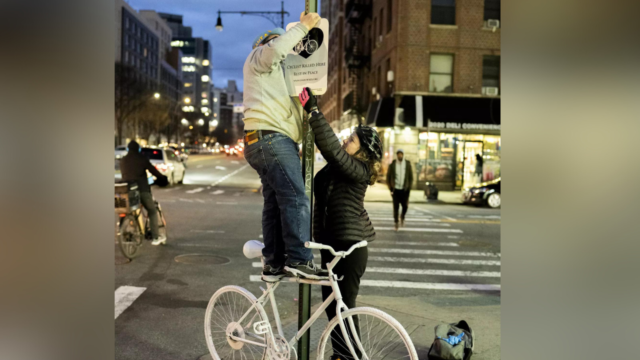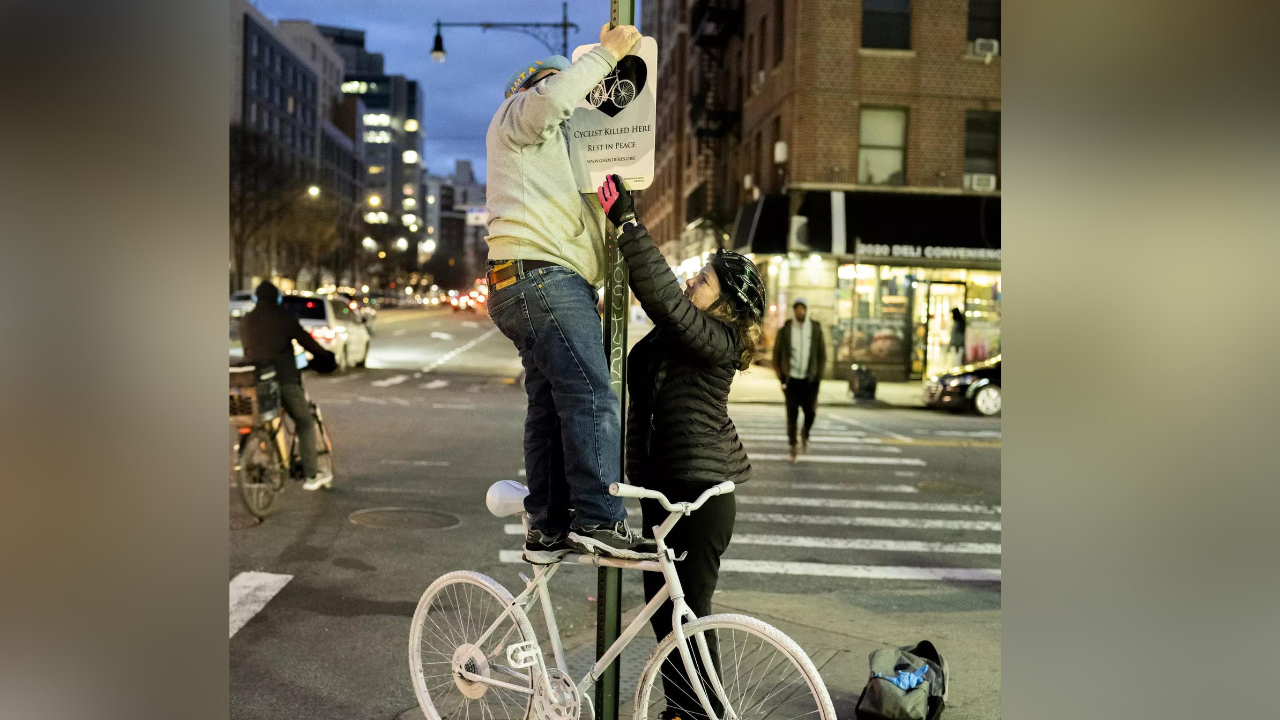
On a chilly Saturday evening in April, Kevin Daloia took a bicycle that he had painted white and locked it to a pole on East 161st Street and Melrose Avenue in the Bronx. Then he climbed up, stood on the seat of the bike and mounted a metal sign on the pole above it. “Cyclist Killed Here/Rest In Peace,” the sign said.
The cyclist, Thierno Balde, was hit by a car on Feb 23 while on his way home from prayers at his mosque.The driver fled after the crash and then ditched a crumpled Jeep Grand Cherokee a few blocks away, according to repo rts. The police said Balde had run a red light. But the authorities also said the driver had been speeding. Daloia didn’t know Balde, but that didn’t matter.
In his free time, Daloia volunteers to paint old bicycles and fasten them to poles as “ghost bikes” for the New York City Street Memorial Project, which consists of installations around the city marking locations where cyclists have died. The bikes — completely white, including tires, spokes and pedals — serve as stark memorials, both an alert to passers-by that a cyclist was killed and a re minder of the dangerous conditions cyclists face in New York. The activistshope to catch the attention of drivers as well.
Daloia isn’t sure how many, exactly, he has erected. “I’ve done this for a long time,” he said. “Anything in the Bronx I’ve touched, and I’ve touched a lot more throughout the city. I don’t know the number, man. Probably 20, 25?” Last year was the deadliest for cyclists in New York since 1999. Thirty cyclists were killed in 2023, according to the city’s department of transportation. Of those, 23 were riding e-bikes. Most fatalities oc curred in collisions with cars and trucks — on streets that did not have dedicated bike lanes.
In New York, a group of artists called Visual Resistance first put up ghost bikes in 2005 in response to a couple of cyclist deaths. “It was supposed to speak more powerfully than words,” said Leah Todd, another volunteer. “A silent but very communicative memorial.” The idea caught on and continues to gain momentum. “We had some grand idea and hope that people would want to care — and want to limit these deaths.”
Ghost bike volunteers recei ve donated bicycles from bike shops, friends or word of mouth. They remove a few essential parts from each bike, rendering it un-ridable and therefore less likely to be stolen. Although cyclist fatalities are usually caused by car crashes, the volunteers who install ghost bikes are not necessarily anti-car. Daloia describes himself as “a cycling traffic safety advocate who starts his car every day”. He believes cars, people and bicycles should be able to coexist peacefully. “I want some of the roads around here to be safer for pedestrians and cyclists.”
The cyclist, Thierno Balde, was hit by a car on Feb 23 while on his way home from prayers at his mosque.The driver fled after the crash and then ditched a crumpled Jeep Grand Cherokee a few blocks away, according to repo rts. The police said Balde had run a red light. But the authorities also said the driver had been speeding. Daloia didn’t know Balde, but that didn’t matter.
In his free time, Daloia volunteers to paint old bicycles and fasten them to poles as “ghost bikes” for the New York City Street Memorial Project, which consists of installations around the city marking locations where cyclists have died. The bikes — completely white, including tires, spokes and pedals — serve as stark memorials, both an alert to passers-by that a cyclist was killed and a re minder of the dangerous conditions cyclists face in New York. The activistshope to catch the attention of drivers as well.
Daloia isn’t sure how many, exactly, he has erected. “I’ve done this for a long time,” he said. “Anything in the Bronx I’ve touched, and I’ve touched a lot more throughout the city. I don’t know the number, man. Probably 20, 25?” Last year was the deadliest for cyclists in New York since 1999. Thirty cyclists were killed in 2023, according to the city’s department of transportation. Of those, 23 were riding e-bikes. Most fatalities oc curred in collisions with cars and trucks — on streets that did not have dedicated bike lanes.
In New York, a group of artists called Visual Resistance first put up ghost bikes in 2005 in response to a couple of cyclist deaths. “It was supposed to speak more powerfully than words,” said Leah Todd, another volunteer. “A silent but very communicative memorial.” The idea caught on and continues to gain momentum. “We had some grand idea and hope that people would want to care — and want to limit these deaths.”
Ghost bike volunteers recei ve donated bicycles from bike shops, friends or word of mouth. They remove a few essential parts from each bike, rendering it un-ridable and therefore less likely to be stolen. Although cyclist fatalities are usually caused by car crashes, the volunteers who install ghost bikes are not necessarily anti-car. Daloia describes himself as “a cycling traffic safety advocate who starts his car every day”. He believes cars, people and bicycles should be able to coexist peacefully. “I want some of the roads around here to be safer for pedestrians and cyclists.”






































